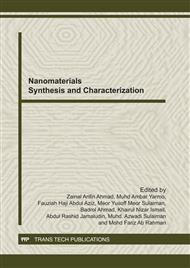p.485
p.489
p.494
p.500
p.504
p.510
p.515
p.519
p.524
Study on Controlled Size, Shape and Dispersity of Gold Nanoparticles (AuNPs) Synthesized via Seeded-Growth Technique for Immunoassay Labeling
Abstract:
This study describes the formation of spherical gold nanoparticles (AuNPs) using a simple seeded-growth technique. The size and surface morphology of AuNPs were investigated using transmission electron microscopy (TEM) and UV-Vis spectrophotometer was used to determine the wavelength and absorption of AuNPs. In the seed stage, the effect of trisodium citrate volume was studied. The size of AuNPs at seed stage was varied from 15 to 40 nm with decreasing volume of trisodium citrate. In the growth stage, the effects of seed solution volume and concentration of hydroxylamine were studied. The size of AuNPs produced became larger when the amount of seed solution was reduced. This approach was beneficial to produce AuNPs with the size range from 15 to 150 nm. The increase of hydroxylamine concentration increased the size of AuNPs. However, after the concentration of hydroxylamine reached supersaturation condition (3 M NH2OH.HCl), the AuNPs formed in a bulk and clusters. Selected sizes of AuNPs were then conjugated to antibody and proved by testing on the immunoassay test strip. The observation using naked eyes for the appearance of red lines on the immunoassay test strip showed that AuNPs were successfully conjugated to antibody and specifically bound to the antigen drawn on the strip assay by tested with positive and negative serum of the disease.
Info:
Periodical:
Pages:
504-509
Citation:
Online since:
October 2011
Price:
Сopyright:
© 2012 Trans Tech Publications Ltd. All Rights Reserved
Share:
Citation:


